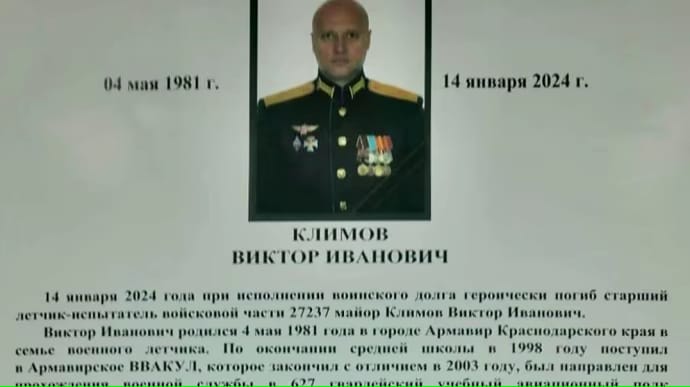The commander of the ill-fated Russian Ilyushin Il-22 M air control center that was shot by Ukrainians over the Sea of Azov has reportedly died in the attack. The co-pilot of the aircraft managed to land the substantially damaged aircraft. The Il-22 is said to have survived the attack but has been damaged beyond repair.
According to reports, the Il-22M11 tail number 75106 was struck by a projectile when it was on a mission in the Strilkove area on the western side of the Sea of Azov. Despite heavy damage, the pilots were able to transmit a distress message and quickly made their way to Anapa Airfield in Russia, located on the Black Sea’s northeastern coast.
“Urgently request an ambulance and fire team,” the crew of the critical aircraft said in an audio recording shared by RBC.
Viktor Klimov, the commanding officer of a Russian Il-22M airborne command post, perished in the attack. Russian social media communities have been reporting that Klimov has been killed in the attack. The co-pilot was also wounded but managed to land the shrapnel-holed aircraft.
“On January 14, 2024, while performing his military duty, the senior test pilot of military unit 27237, Major Viktor Ivanovich Klimov, died heroically,” a citation floating on a local Telegram-based news outlet said.

The propeller-driven Il-22 had a crew of 10 people on board when it managed to land in Anapa on the Russian side of the Sea of Azov’s southern coast.
The Il-22 and the A-50 AWACS are among the most expensive and valuable assets in the Russian radar and command fleet. The two aircraft were flying about 100 miles from the front line.
With the A-50 crashing in the Sea of Azov and the Il-22 being rendered unflightworthy, January 14 would mark the single worst day for the Russian Air Force since the beginning of the war.
According to the 2023 World Air Forces directory, the Russian Air Force operated 30 Il-22 aircraft.
Images of the wrecked Il-22, taken just after it touched down, show the precise model of the aircraft as well as the degree of the damage, which includes a shredded tail fin and fuselage. It is an Il-22M11, and it may be completely written off.
This is an uncommon version of the Ilyushin turboprop from the 1950s. After one of the planes was shot down by renegade Wagner Group mercenaries over western Russia in June 2023, the Russian air force is believed to possess approximately twelve Il-22Ms.
Although the Russians could convert an outdated Ilyushin airframe into a replacement Il-22M, it is going to be time-consuming and expensive. Hundreds of millions of dollars may be spent on an A-50 or Il-22M.
Over 40 A-50s were built in the 1980s and 1990s, but as of 2022, only about 16 remained, with nine to eleven of them being in flyable condition. Since late 2022, reports have indicated that only three of these aircraft are still “fully mission capable” (FMC), meaning all its equipment is completely functioning. This is because they were used extensively in the early months of the Russian invasion of Ukraine.
The crash of the jet-propelled A-50 reportedly killed all 15 people onboard. They were high-ranking officers and highly-trained radar specialists.
Ukrainian Ambush
As reported by the EurAsian Times, the aircraft were downed by Ukrainians, probably by laying an elaborate trap. The prelude to the January 14th kill was laid on January 13, when Ukrainian Air Force jets, most likely Sukhoi Su-24 bombers, pounded Russian Air Force installations across the Russian-controlled Crimea Peninsula and knocked out several radars.
The Russians ordered one of their A-50Us to get airborne. Considering the aircraft had “insufficient” equipment” for the task, an Il-22M airborne command post accompanied it. Also, because of the short radar range of the A-50U, it had to operate close to the frontline (as close as 80-90 kilometers from it) to detect incoming Ukrainian aircraft and missiles.
On January 13, following the Ukrainian air strikes, the A-50U and Il-22 M were ordered to fly closer to the frontline. They were probably escorted by at least a pair of Su-30SM interceptors.
This flying activity helped Ukraine plan to lay down a trap for the Russian aircraft. Ukrainian air strikes on the Russian air defense systems on the Crimean Peninsula on January 13 forced the Russians to react the way Ukrainians could predict them to react: a day later, on January 14, they ‘pushed’ their A-50U closer to the frontline.
On January 14, one Russian Su-34 reported that its electronic warfare systems recorded a radar emission of a Ukrainian S-300 (NATO moniker SA-10 Grumble), which was not known to be there earlier.
The Ukrainians switched on the S-300 and made its location known to the Russian fighter jets. The S-300 radar detected suitable targets and provided “their azimuth and range” to the PAC-2/3 SAM system. The Patriot powered up its radar for only a few seconds: “long enough to obtain its targeting data, but too short for the Russians to dependably detect its emissions and assess them as a threat.”
After this, the Ukrainians fired their missiles. Immediately after hitting the target, the Ukrainian S-300 and PAC2/3 crews promptly ceased emitting and packed up their systems to avoid possible Russian retribution.
- Ritu Sharma has been a journalist for over a decade, writing on defense, foreign affairs, and nuclear technology.
- She can be reached at ritu.sharma (at) mail.com
- Follow EurAsian Times on Google News